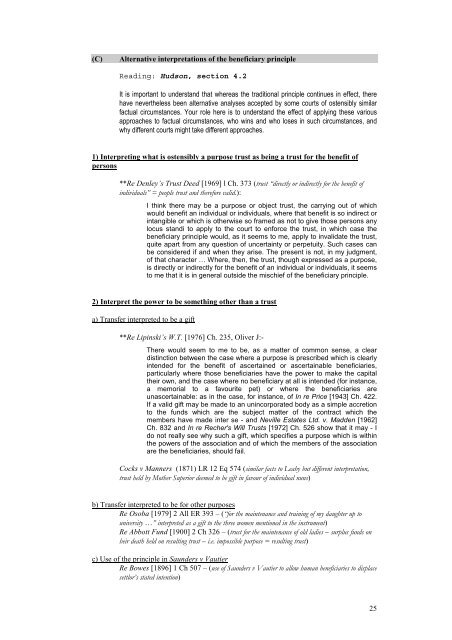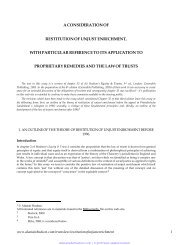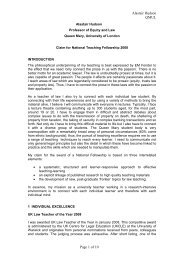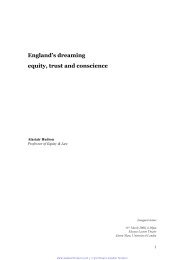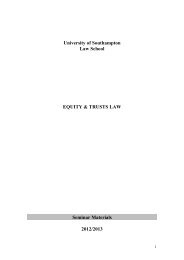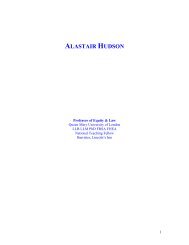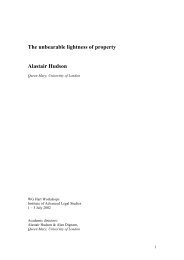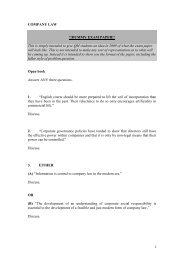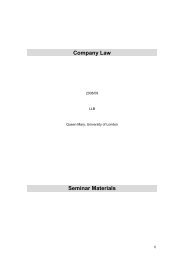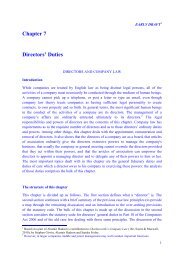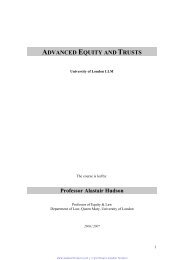Soton Equity and Trusts - alastairhudson.com
Soton Equity and Trusts - alastairhudson.com
Soton Equity and Trusts - alastairhudson.com
You also want an ePaper? Increase the reach of your titles
YUMPU automatically turns print PDFs into web optimized ePapers that Google loves.
(C)<br />
Alternative interpretations of the beneficiary principle<br />
Reading: Hudson, section 4.2<br />
It is important to underst<strong>and</strong> that whereas the traditional principle continues in effect, there<br />
have nevertheless been alternative analyses accepted by some courts of ostensibly similar<br />
factual circumstances. Your role here is to underst<strong>and</strong> the effect of applying these various<br />
approaches to factual circumstances, who wins <strong>and</strong> who loses in such circumstances, <strong>and</strong><br />
why different courts might take different approaches.<br />
1) Interpreting what is ostensibly a purpose trust as being a trust for the benefit of<br />
persons<br />
**Re Denley’s Trust Deed [1969] l Ch. 373 (trust “directly or indirectly for the benefit of<br />
individuals” = people trust <strong>and</strong> therefore valid.):<br />
I think there may be a purpose or object trust, the carrying out of which<br />
would benefit an individual or individuals, where that benefit is so indirect or<br />
intangible or which is otherwise so framed as not to give those persons any<br />
locus st<strong>and</strong>i to apply to the court to enforce the trust, in which case the<br />
beneficiary principle would, as it seems to me, apply to invalidate the trust,<br />
quite apart from any question of uncertainty or perpetuity. Such cases can<br />
be considered if <strong>and</strong> when they arise. The present is not, in my judgment,<br />
of that character … Where, then, the trust, though expressed as a purpose,<br />
is directly or indirectly for the benefit of an individual or individuals, it seems<br />
to me that it is in general outside the mischief of the beneficiary principle.<br />
2) Interpret the power to be something other than a trust<br />
a) Transfer interpreted to be a gift<br />
**Re Lipinski’s W.T. [1976] Ch. 235, Oliver J:-<br />
There would seem to me to be, as a matter of <strong>com</strong>mon sense, a clear<br />
distinction between the case where a purpose is prescribed which is clearly<br />
intended for the benefit of ascertained or ascertainable beneficiaries,<br />
particularly where those beneficiaries have the power to make the capital<br />
their own, <strong>and</strong> the case where no beneficiary at all is intended (for instance,<br />
a memorial to a favourite pet) or where the beneficiaries are<br />
unascertainable: as in the case, for instance, of In re Price [1943] Ch. 422.<br />
If a valid gift may be made to an unincorporated body as a simple accretion<br />
to the funds which are the subject matter of the contract which the<br />
members have made inter se - <strong>and</strong> Neville Estates Ltd. v. Madden [1962]<br />
Ch. 832 <strong>and</strong> In re Recher's Will <strong>Trusts</strong> [1972] Ch. 526 show that it may - I<br />
do not really see why such a gift, which specifies a purpose which is within<br />
the powers of the association <strong>and</strong> of which the members of the association<br />
are the beneficiaries, should fail.<br />
Cocks v Manners (1871) LR 12 Eq 574 (similar facts to Leahy but different interpretation,<br />
trust held by Mother Superior deemed to be gift in favour of individual nuns)<br />
b) Transfer interpreted to be for other purposes<br />
Re Osoba [1979] 2 All ER 393 – (“for the maintenance <strong>and</strong> training of my daughter up to<br />
university …” interpreted as a gift to the three women mentioned in the instrument)<br />
Re Abbott Fund [1900] 2 Ch 326 – (trust for the maintenance of old ladies – surplus funds on<br />
heir death held on resulting trust – i.e. impossible purpose = resulting trust)<br />
c) Use of the principle in Saunders v Vautier<br />
Re Bowes [1896] 1 Ch 507 – (use of Saunders v Vautier to allow human beneficiaries to displace<br />
settlor’s stated intention)<br />
25


